Dr. Steve Wallace shares useful tips on how to promote and present research papers
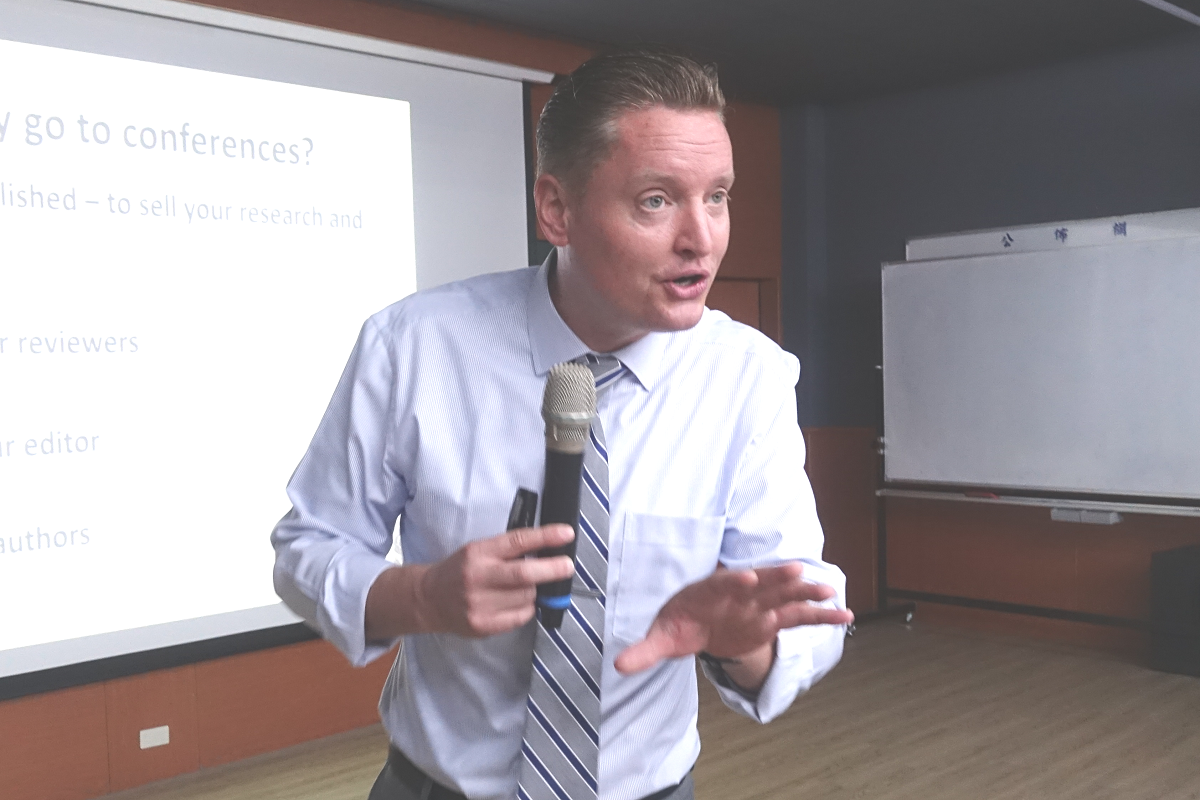
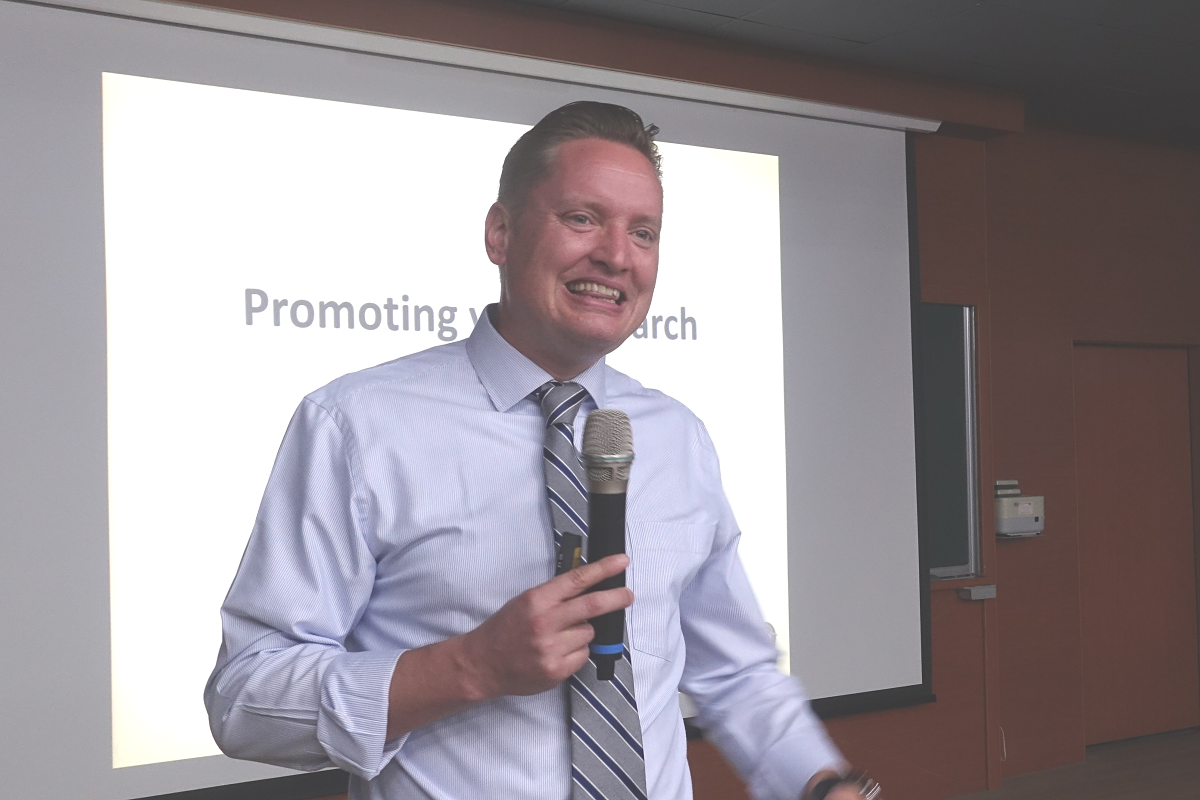
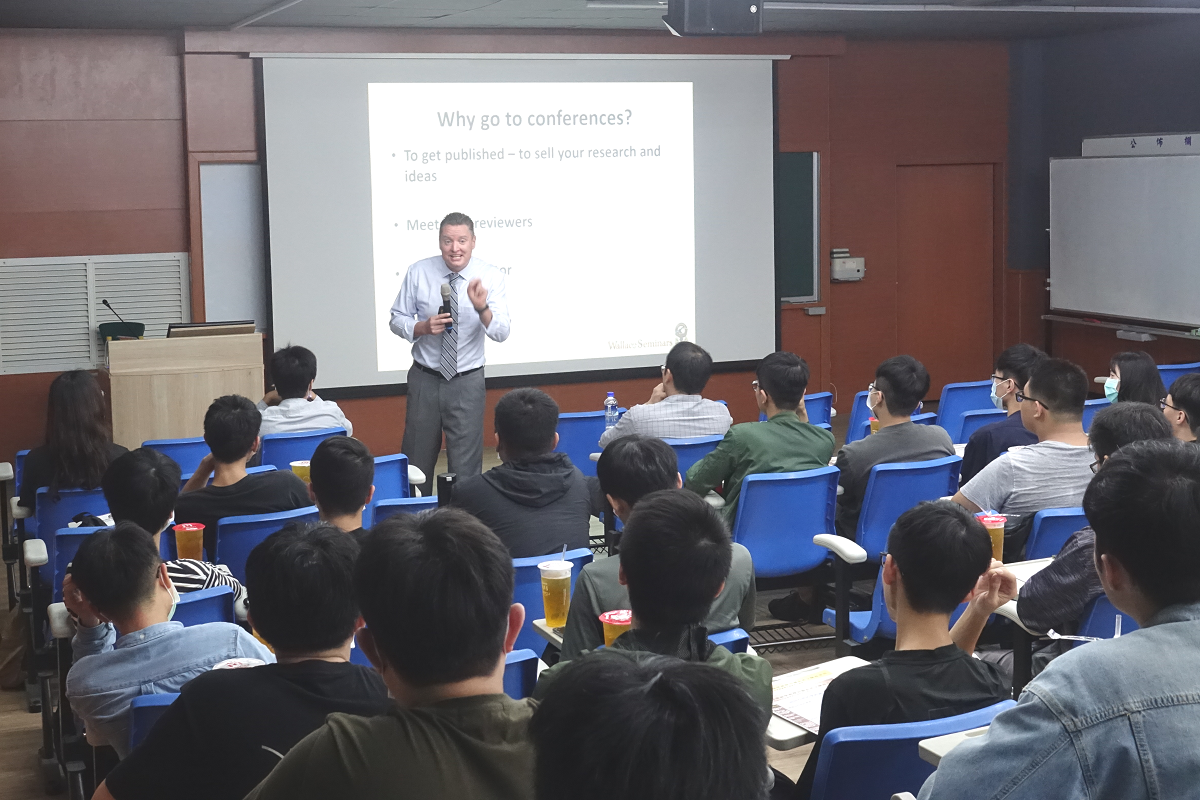
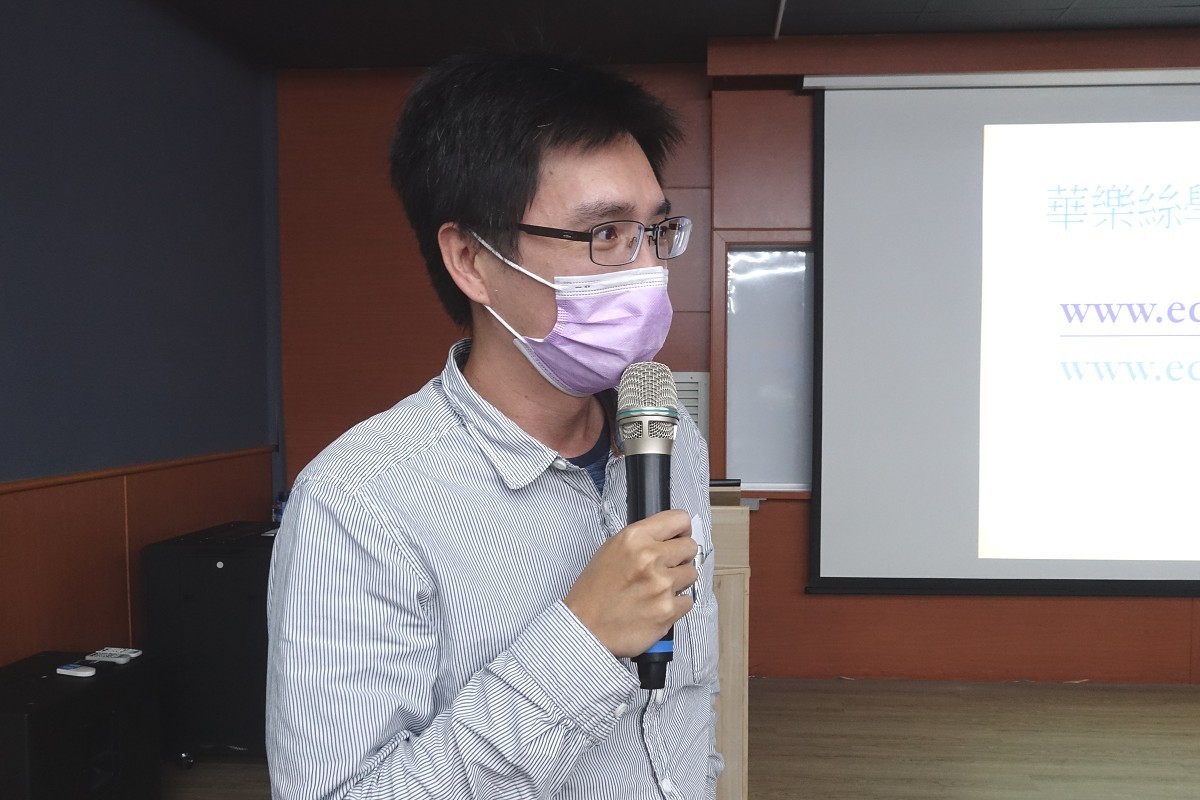
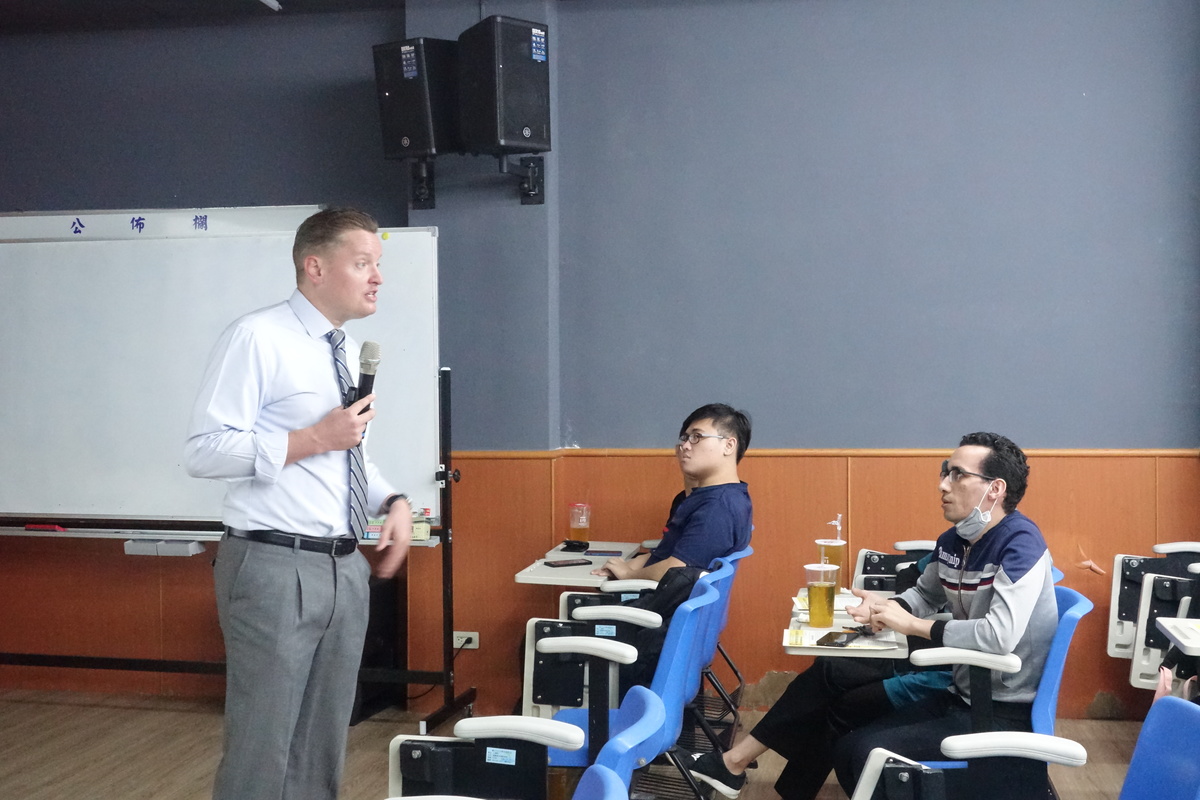
Founder of Wallace Academic Editing Dr. Steve Wallace visited NSYSU College of Engineering (CoE) to give a speech to about 50 participating students on how to effectively promote and present a research paper during academic conferences. Dr. Wallace, who has years-long experience as editor of academic texts in English and as teacher of academic English writing, shared a series of useful tips on how to meet and connect with key persons in one’s research career as well as introduce one’s research effectively.
Warmly welcomed by Assistant Professor Wei-Chun Lin of the Department of Photonics (DP), Dr. Wallace started his speech by explaining why conferences are important to promote research papers. “Conference is your show-off time”, said Dr. Wallace. A conference is a great opportunity to present your research, as well as get together with the small circle of people from your domain and meet potential collaborators, your future boss, reviewers and editors from all over the world.
Dr. Wallace emphasized the importance of choosing the right conferences to attend, as well as thoroughly preparing before the event. Check on Google Scholar what conferences do the authors you cite in your paper join – reviewers are usually chosen by the editors from the references in your own paper, so choose the conferences relevant to your field to meet the right people, he advised. Before the conference, prepare name cards, register early, and review the schedule to make own plan for attendance. You might be asked about your research, so prepare a one-minute introduction to your research, a longer version of it, as well as print out copies of your research paper and resume to hand out, he said. Join reviewer sessions and ask easy and friendly questions after sessions to connect with the speaker. Staying at the conference hotel might further increase the chance of interaction with people.
Many people are afraid of public speaking – when presenting one’s research during a conference, the first thing to do is to calm down: “Make your body pretend you are brave and you will fool yourself into thinking of being brave”. First make eye contact with the friendliest-looking faces, and then, having gained more confidence, make eye contact with the whole audience, Dr. Wallace advised. To prepare a good presentation, it is a good idea to outline the key points and practice saying them in different ways with a timing device, while breathing naturally, he advised. Changing the speed, volume, and using the whole range of your voice can make people follow you more easily and understand what you are saying. State facts and results in a low voice at the end of the sentence, and remember that being too loud is better than being too quiet, he said. Because the audience may come from all over the world, it is better to “keep the big words in the dictionary”, pronounce clearly, and speak simple English.
After each presentation, there is usually a Q&A session – a valuable opportunity to create interaction with the audience and get feedback: questions and suggestions can be useful to modify your paper. Dr. Wallace provided a few ideas on how to encourage the audience to ask questions: you can ask the first question and answer it yourself or arrange somebody to do it for you or ask the listeners to write their questions on a whiteboard or paper; it is also a good idea to start creating interaction with the audience during the presentation, and provide a good seat arrangement to foster interaction, if possible. Many speakers are afraid of the Q&A session – to be more confident, prepare answers for the bad questions and additional backup slides for potential questions. Don’t be afraid to say you don’t know the answer – you can always refer the questioner to somebody else. Also, print out the references in your research. Avoid answering lengthy methodology questions during the session. Give a clear ending to the Q&A session with a second conclusion and leave slowly to let people catch you for additional questions, Wallace recommended.
After the lecture, Dr. Wallace engaged in a lively QA session with the audience – about 50 undergraduate, Master and PhD students of the DP. The students had more ideas about how to promote their research papers – Era, a fourth-year PhD student from Indonesia said that she connects with potential reviewers and editors watching their speeches on YouTube and connecting with them through comments and emails, as well as via the Google Scholar platform.
The event was organized by the CoE and the DP as part of the English Learning Portfolio Project, aimed at improving students’ English language abilities. Professor Tsung-Hsien Lin – Chairman of the DP, who invited Dr. Wallace to give the speech, said that although the CoE is already very internationalized, for the outstanding research achievements of the CoE to be noticed, researchers’ papers need to be published in top international journals and thus they need to continually improve their English writing skills. What is more, to promote research productivity, the CoE established a system of incentives, scholarships, and awards for the faculty and students of programs of all levels to participate in research projects, gain research experience and strive for the best academic research results.
Dr. Steve Wallace has nearly 20 years of experience in translation, editing, and review of research papers in English for publication in scientific journals and teaching classes in technical writing and conference presentation at several universities in Taiwan, Hong Kong, and China. Dr. Wallace published 12 academic textbooks and established Wallace Academic Editing to help Taiwanese researchers publish their papers in English in international journals.
Warmly welcomed by Assistant Professor Wei-Chun Lin of the Department of Photonics (DP), Dr. Wallace started his speech by explaining why conferences are important to promote research papers. “Conference is your show-off time”, said Dr. Wallace. A conference is a great opportunity to present your research, as well as get together with the small circle of people from your domain and meet potential collaborators, your future boss, reviewers and editors from all over the world.
Dr. Wallace emphasized the importance of choosing the right conferences to attend, as well as thoroughly preparing before the event. Check on Google Scholar what conferences do the authors you cite in your paper join – reviewers are usually chosen by the editors from the references in your own paper, so choose the conferences relevant to your field to meet the right people, he advised. Before the conference, prepare name cards, register early, and review the schedule to make own plan for attendance. You might be asked about your research, so prepare a one-minute introduction to your research, a longer version of it, as well as print out copies of your research paper and resume to hand out, he said. Join reviewer sessions and ask easy and friendly questions after sessions to connect with the speaker. Staying at the conference hotel might further increase the chance of interaction with people.
Many people are afraid of public speaking – when presenting one’s research during a conference, the first thing to do is to calm down: “Make your body pretend you are brave and you will fool yourself into thinking of being brave”. First make eye contact with the friendliest-looking faces, and then, having gained more confidence, make eye contact with the whole audience, Dr. Wallace advised. To prepare a good presentation, it is a good idea to outline the key points and practice saying them in different ways with a timing device, while breathing naturally, he advised. Changing the speed, volume, and using the whole range of your voice can make people follow you more easily and understand what you are saying. State facts and results in a low voice at the end of the sentence, and remember that being too loud is better than being too quiet, he said. Because the audience may come from all over the world, it is better to “keep the big words in the dictionary”, pronounce clearly, and speak simple English.
After each presentation, there is usually a Q&A session – a valuable opportunity to create interaction with the audience and get feedback: questions and suggestions can be useful to modify your paper. Dr. Wallace provided a few ideas on how to encourage the audience to ask questions: you can ask the first question and answer it yourself or arrange somebody to do it for you or ask the listeners to write their questions on a whiteboard or paper; it is also a good idea to start creating interaction with the audience during the presentation, and provide a good seat arrangement to foster interaction, if possible. Many speakers are afraid of the Q&A session – to be more confident, prepare answers for the bad questions and additional backup slides for potential questions. Don’t be afraid to say you don’t know the answer – you can always refer the questioner to somebody else. Also, print out the references in your research. Avoid answering lengthy methodology questions during the session. Give a clear ending to the Q&A session with a second conclusion and leave slowly to let people catch you for additional questions, Wallace recommended.
After the lecture, Dr. Wallace engaged in a lively QA session with the audience – about 50 undergraduate, Master and PhD students of the DP. The students had more ideas about how to promote their research papers – Era, a fourth-year PhD student from Indonesia said that she connects with potential reviewers and editors watching their speeches on YouTube and connecting with them through comments and emails, as well as via the Google Scholar platform.
The event was organized by the CoE and the DP as part of the English Learning Portfolio Project, aimed at improving students’ English language abilities. Professor Tsung-Hsien Lin – Chairman of the DP, who invited Dr. Wallace to give the speech, said that although the CoE is already very internationalized, for the outstanding research achievements of the CoE to be noticed, researchers’ papers need to be published in top international journals and thus they need to continually improve their English writing skills. What is more, to promote research productivity, the CoE established a system of incentives, scholarships, and awards for the faculty and students of programs of all levels to participate in research projects, gain research experience and strive for the best academic research results.
Dr. Steve Wallace has nearly 20 years of experience in translation, editing, and review of research papers in English for publication in scientific journals and teaching classes in technical writing and conference presentation at several universities in Taiwan, Hong Kong, and China. Dr. Wallace published 12 academic textbooks and established Wallace Academic Editing to help Taiwanese researchers publish their papers in English in international journals.
Click Num:
Share
